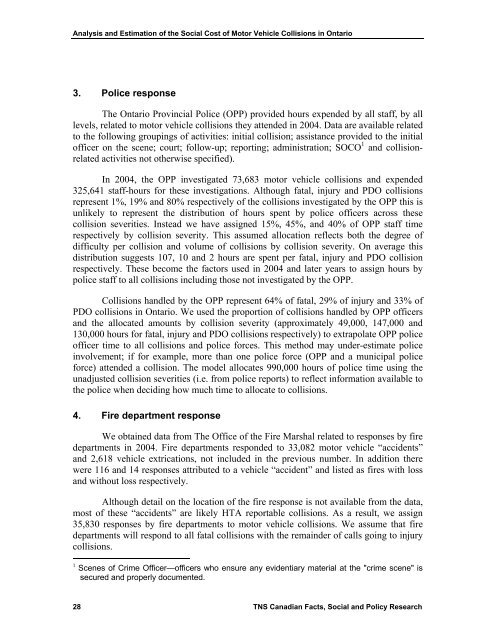Keith Vodden Dr. Douglas Smith - Transports Canada
Keith Vodden Dr. Douglas Smith - Transports Canada
Keith Vodden Dr. Douglas Smith - Transports Canada
You also want an ePaper? Increase the reach of your titles
YUMPU automatically turns print PDFs into web optimized ePapers that Google loves.
Analysis and Estimation of the Social Cost of Motor Vehicle Collisions in Ontario<br />
3. Police response<br />
The Ontario Provincial Police (OPP) provided hours expended by all staff, by all<br />
levels, related to motor vehicle collisions they attended in 2004. Data are available related<br />
to the following groupings of activities: initial collision; assistance provided to the initial<br />
officer on the scene; court; follow-up; reporting; administration; SOCO 1 and collisionrelated<br />
activities not otherwise specified).<br />
In 2004, the OPP investigated 73,683 motor vehicle collisions and expended<br />
325,641 staff-hours for these investigations. Although fatal, injury and PDO collisions<br />
represent 1%, 19% and 80% respectively of the collisions investigated by the OPP this is<br />
unlikely to represent the distribution of hours spent by police officers across these<br />
collision severities. Instead we have assigned 15%, 45%, and 40% of OPP staff time<br />
respectively by collision severity. This assumed allocation reflects both the degree of<br />
difficulty per collision and volume of collisions by collision severity. On average this<br />
distribution suggests 107, 10 and 2 hours are spent per fatal, injury and PDO collision<br />
respectively. These become the factors used in 2004 and later years to assign hours by<br />
police staff to all collisions including those not investigated by the OPP.<br />
Collisions handled by the OPP represent 64% of fatal, 29% of injury and 33% of<br />
PDO collisions in Ontario. We used the proportion of collisions handled by OPP officers<br />
and the allocated amounts by collision severity (approximately 49,000, 147,000 and<br />
130,000 hours for fatal, injury and PDO collisions respectively) to extrapolate OPP police<br />
officer time to all collisions and police forces. This method may under-estimate police<br />
involvement; if for example, more than one police force (OPP and a municipal police<br />
force) attended a collision. The model allocates 990,000 hours of police time using the<br />
unadjusted collision severities (i.e. from police reports) to reflect information available to<br />
the police when deciding how much time to allocate to collisions.<br />
4. Fire department response<br />
We obtained data from The Office of the Fire Marshal related to responses by fire<br />
departments in 2004. Fire departments responded to 33,082 motor vehicle “accidents”<br />
and 2,618 vehicle extrications, not included in the previous number. In addition there<br />
were 116 and 14 responses attributed to a vehicle “accident” and listed as fires with loss<br />
and without loss respectively.<br />
Although detail on the location of the fire response is not available from the data,<br />
most of these “accidents” are likely HTA reportable collisions. As a result, we assign<br />
35,830 responses by fire departments to motor vehicle collisions. We assume that fire<br />
departments will respond to all fatal collisions with the remainder of calls going to injury<br />
collisions.<br />
1 Scenes of Crime Officer—officers who ensure any evidentiary material at the "crime scene" is<br />
secured and properly documented.<br />
28 TNS Canadian Facts, Social and Policy Research
















